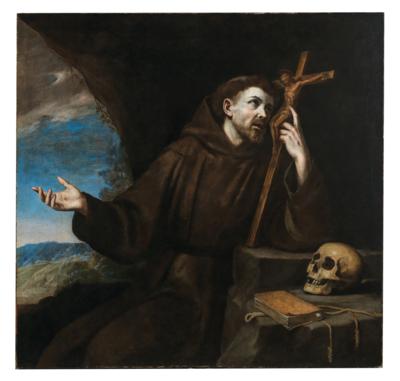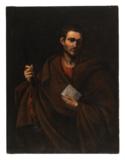Jusepe de Ribera

(Xàtiva 1591–1652 Naples)
The penitent Saint Francis,
oil on canvas, 123.5 x 128 cm, framed
Provenance:
sale, Sotheby’s, London, 9 July 2009, lot 156 (as Neapolitan School, 17th Century);
where acquired by the present owner
Literature:
N. Spinosa, Pittura del Seicento a Napoli. Da Caravaggio a Massimo Stanzione, Naples 2010, pp. 374–375, cat. no. 371 (as Jusepe de Ribera)
The present composition shows the penitent Saint Francis adoring the crucifix after receiving the stigmata at Porziuncola near Assisi. The skull on the rock in the right foreground serves to focus the saint’s meditation on mortality.
Spinosa has dated the present work to around 1640 and this painting can be compared to two other works by the artist, the Saint Peter at Prayer executed around 1640 (whereabouts unknown, see N. Spinosa, Ribera: la obra completa, Madrid 2008, p. 438, cat. no. A272), and the Saint Francis in Ecstasy of 1642, conserved in the Monastery of San Lorenzo in the Escorial for which Ribera may have used the same model.
Three-quarter length paintings of saints represented in penitence or in meditation are frequent in Ribera’s oeuvre, and were probably conceived to conform to the sober counter-reformation spirituality of his Spanish and Neapolitan patrons. The Penitent Magdalene and the Saint Bartholomew from the signed and dated series of 1641 in the Museo del Prado, Madrid (inv. no P001103; inv. no. P001100) are typical for these representations, as well as the painting of Saint Francis in meditation in the Galleria Palatina of Palazzo Pitti, Florence (inv. no. 1912 no. 73, signed and dated 1643), all similar to the present composition.
In the 1640s Ribera’s career was already well established in Naples. Here the artist explored the ‘tenebrist’ tradition creating dramatic works articulated through contrasts of light and shadow. Like many artists who had seen the works of Caravaggio in Rome or Naples, Ribera was struck by his technique and experimented with light to create contrasts of chiaroscuro. He never became a direct follower of Caravaggio however, instead expanding the painter’s notions of realism, thereby developing his own signature style, which is a visceral and essentially Spanish declination of the realist style.
Technical analysis by Gianluca Poldi:
Scientific analysis carried out on this painting reveals its quality. The work is painted over a dark brown ground and some changes occurred, as IRR images indicate: the arms of the crucifix were shorter, so it was enlarged to host the Crucified Christ; the right sleeve of St. Francis’s habit was originally longer and the profile of the mountain towards the sky was reduced a little. The latter changes gave light to the ‘window’ of the landscape, where the mid-blue mass of the tree completes the horizontal mass of the mountains in the background. The habit was also modified on the chest, where the almost vertical folds point directly to the head of the saint, while in the first painted idea the neckline of the habit was larger and semicircular, as if the hood were a different element added to the habit.
The palette is simple, as spectroscopic investigations state: ochre and brown earths, lead white, lapis lazuli used in the external painting layer of the sky and in some areas of the bluish vegetation, smalt blue that was instead employed in the underlayer of the sky, similarly to the fifteenth and sixteenth century practice of using a double layer of blue, sometimes, in that case typically lapis lazuli over azurite. The green vegetation of the landscape is obtained mainly by smalt blue mixed with an iron oxide-based pigment (ochre or earth). Flesh tones contain vermillion, and ochre added to lead white, in different proportions. The brushstrokes of the flesh tones are accurate, simply describing the mid-tones and some full light, like that enlightening the eyes.
IR reflectography also reveals the rocky structure of the cave that, together with the cross, the book and the skull links the image to the meditative subjects of St. Jerome or the Penitent Magdalene. A more thorough reading of the darker areas permits an appreciation the painter’s construction of a subtle balance between light and shade and also the play of straight and curved lines, along the diagonals: the curve of the border of the cave, on the left, is repeated, as IRR shows, in the dark rock behind St. Francis’ head, parallel to his arm holding the crucifix.
Esperto: Mark MacDonnell
 Mark MacDonnell
Mark MacDonnell
+43 1 515 60 403
oldmasters@dorotheum.com
03.05.2023 - 18:00
- Prezzo realizzato: **
-
EUR 80.600,-
- Stima:
-
EUR 80.000,- a EUR 120.000,-
Jusepe de Ribera
(Xàtiva 1591–1652 Naples)
The penitent Saint Francis,
oil on canvas, 123.5 x 128 cm, framed
Provenance:
sale, Sotheby’s, London, 9 July 2009, lot 156 (as Neapolitan School, 17th Century);
where acquired by the present owner
Literature:
N. Spinosa, Pittura del Seicento a Napoli. Da Caravaggio a Massimo Stanzione, Naples 2010, pp. 374–375, cat. no. 371 (as Jusepe de Ribera)
The present composition shows the penitent Saint Francis adoring the crucifix after receiving the stigmata at Porziuncola near Assisi. The skull on the rock in the right foreground serves to focus the saint’s meditation on mortality.
Spinosa has dated the present work to around 1640 and this painting can be compared to two other works by the artist, the Saint Peter at Prayer executed around 1640 (whereabouts unknown, see N. Spinosa, Ribera: la obra completa, Madrid 2008, p. 438, cat. no. A272), and the Saint Francis in Ecstasy of 1642, conserved in the Monastery of San Lorenzo in the Escorial for which Ribera may have used the same model.
Three-quarter length paintings of saints represented in penitence or in meditation are frequent in Ribera’s oeuvre, and were probably conceived to conform to the sober counter-reformation spirituality of his Spanish and Neapolitan patrons. The Penitent Magdalene and the Saint Bartholomew from the signed and dated series of 1641 in the Museo del Prado, Madrid (inv. no P001103; inv. no. P001100) are typical for these representations, as well as the painting of Saint Francis in meditation in the Galleria Palatina of Palazzo Pitti, Florence (inv. no. 1912 no. 73, signed and dated 1643), all similar to the present composition.
In the 1640s Ribera’s career was already well established in Naples. Here the artist explored the ‘tenebrist’ tradition creating dramatic works articulated through contrasts of light and shadow. Like many artists who had seen the works of Caravaggio in Rome or Naples, Ribera was struck by his technique and experimented with light to create contrasts of chiaroscuro. He never became a direct follower of Caravaggio however, instead expanding the painter’s notions of realism, thereby developing his own signature style, which is a visceral and essentially Spanish declination of the realist style.
Technical analysis by Gianluca Poldi:
Scientific analysis carried out on this painting reveals its quality. The work is painted over a dark brown ground and some changes occurred, as IRR images indicate: the arms of the crucifix were shorter, so it was enlarged to host the Crucified Christ; the right sleeve of St. Francis’s habit was originally longer and the profile of the mountain towards the sky was reduced a little. The latter changes gave light to the ‘window’ of the landscape, where the mid-blue mass of the tree completes the horizontal mass of the mountains in the background. The habit was also modified on the chest, where the almost vertical folds point directly to the head of the saint, while in the first painted idea the neckline of the habit was larger and semicircular, as if the hood were a different element added to the habit.
The palette is simple, as spectroscopic investigations state: ochre and brown earths, lead white, lapis lazuli used in the external painting layer of the sky and in some areas of the bluish vegetation, smalt blue that was instead employed in the underlayer of the sky, similarly to the fifteenth and sixteenth century practice of using a double layer of blue, sometimes, in that case typically lapis lazuli over azurite. The green vegetation of the landscape is obtained mainly by smalt blue mixed with an iron oxide-based pigment (ochre or earth). Flesh tones contain vermillion, and ochre added to lead white, in different proportions. The brushstrokes of the flesh tones are accurate, simply describing the mid-tones and some full light, like that enlightening the eyes.
IR reflectography also reveals the rocky structure of the cave that, together with the cross, the book and the skull links the image to the meditative subjects of St. Jerome or the Penitent Magdalene. A more thorough reading of the darker areas permits an appreciation the painter’s construction of a subtle balance between light and shade and also the play of straight and curved lines, along the diagonals: the curve of the border of the cave, on the left, is repeated, as IRR shows, in the dark rock behind St. Francis’ head, parallel to his arm holding the crucifix.
Esperto: Mark MacDonnell
 Mark MacDonnell
Mark MacDonnell
+43 1 515 60 403
oldmasters@dorotheum.com
|
Hotline dell'acquirente
lun-ven: 10.00 - 17.00
old.masters@dorotheum.at +43 1 515 60 403 |
| Asta: | Dipinti antichi |
| Tipo d'asta: | Asta in sala con Live Bidding |
| Data: | 03.05.2023 - 18:00 |
| Luogo dell'asta: | Wien | Palais Dorotheum |
| Esposizione: | 22.04. - 03.05.2023 |
** Prezzo d’acquisto comprensivo dei diritti d’asta acquirente e IVA
Non è più possibile effettuare un ordine di acquisto su Internet. L'asta è in preparazione o è già stata eseguita.

